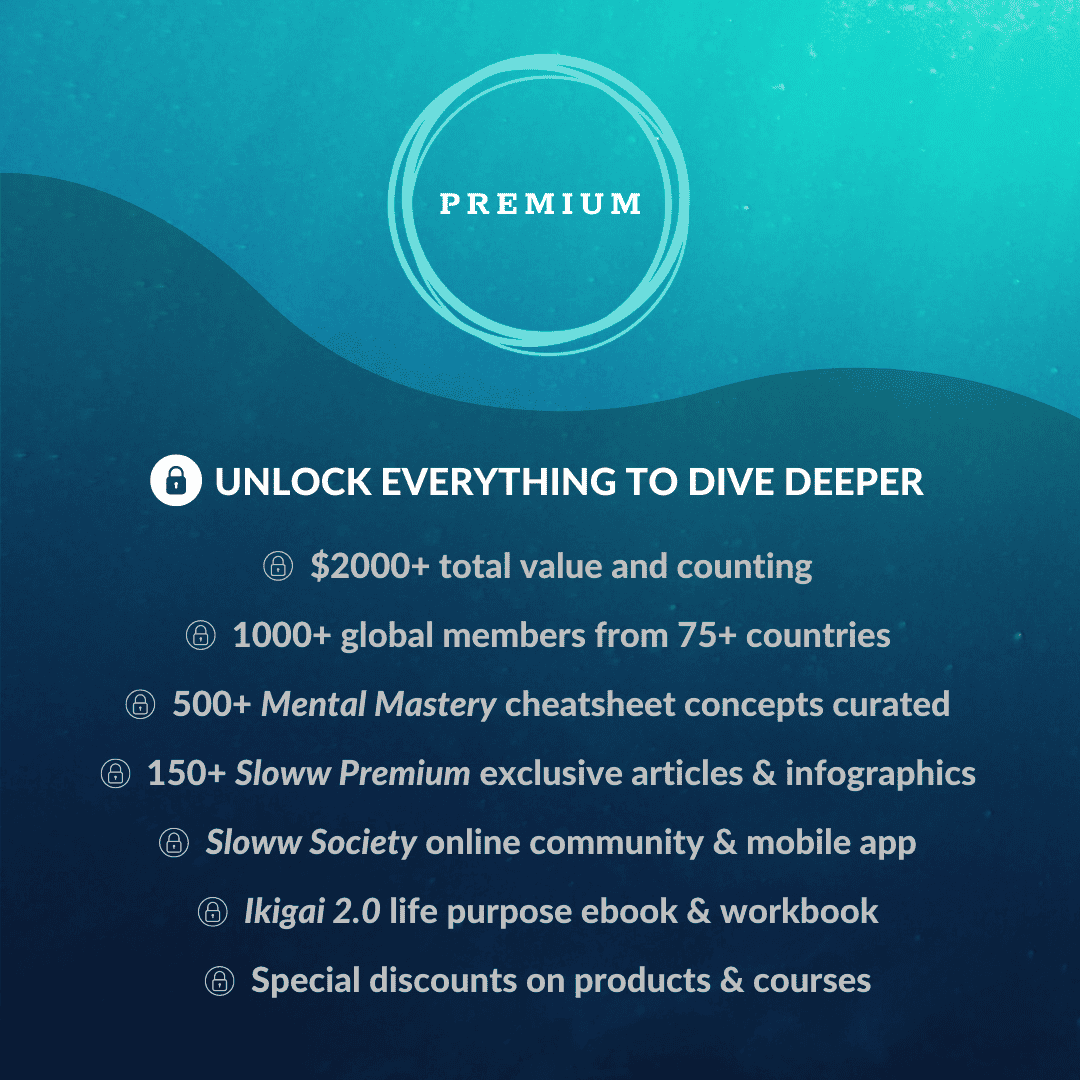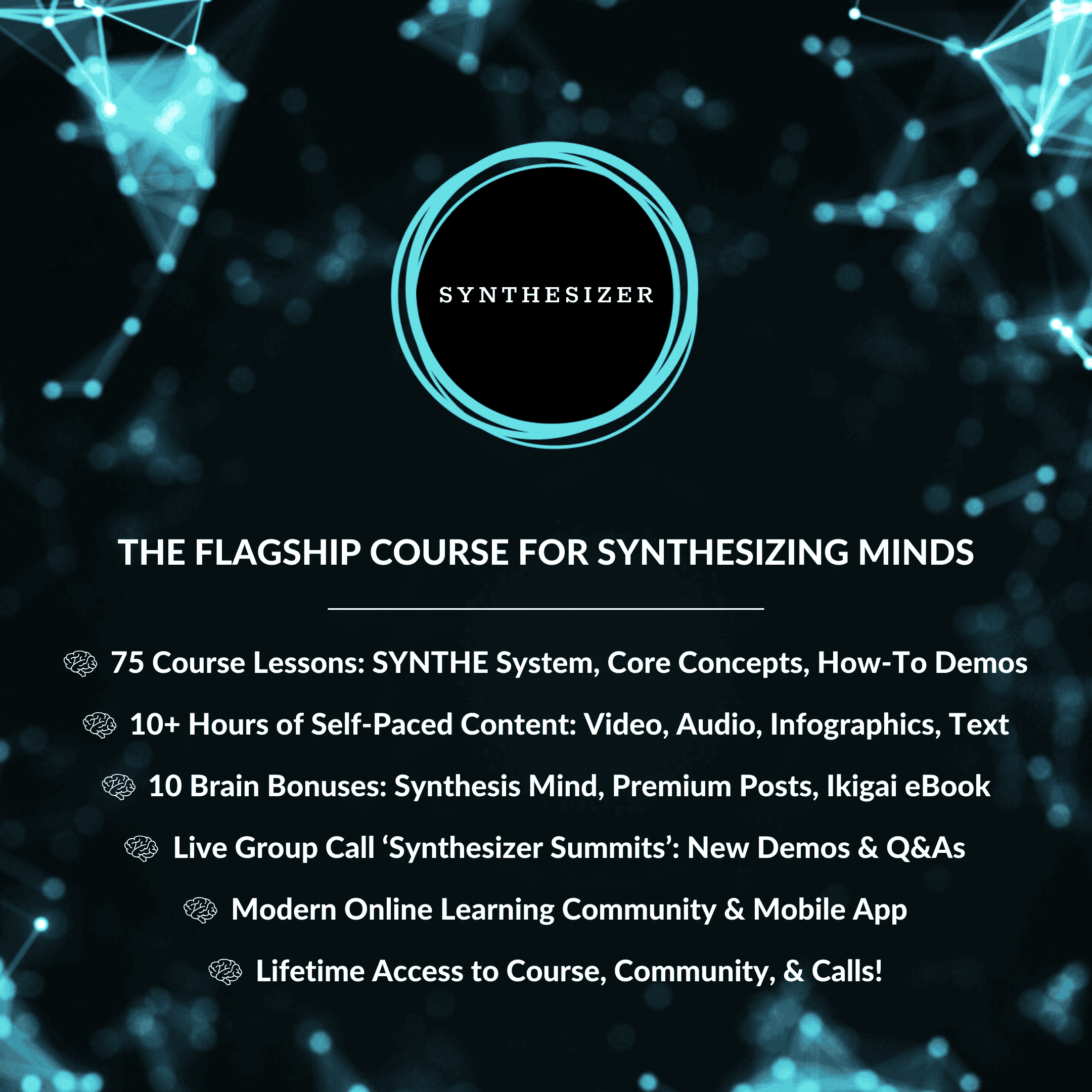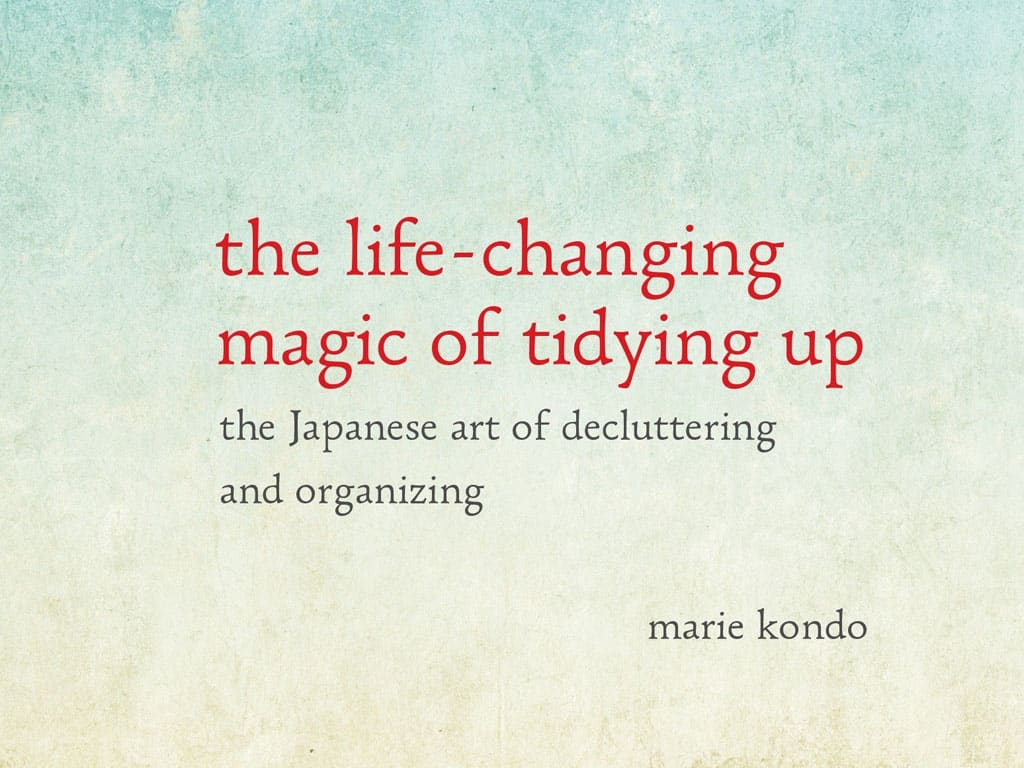
Wow! It’s been a bit since I’ve said that after reading a book. There’s a reason this book, Marie Kondo, and the KonMari Method are global sensations.
It has it all — philosophical wisdom, Japanese cultural traditions, and practical advice based on a lot of real experience and trial and error.
Like most people by now, I was aware of Marie Kondo and her selection criteria of, “Does it spark joy?” I’d also seen some videos of her describing parts of her process. But, I didn’t realize what I was missing by not having read her book cover to cover.
She’s sassy! I’m not sure if it’s her personality, the English translation, or both, but the book is quite entertaining and direct.
I have a whole new level of respect for Marie Kondo after reading the book. She’s the epitome of understanding a complex subject so thoroughly that she can explain it simply. That’s what true experts do that everyone else wishes they could do.
Quick Summary of The Life-Changing Magic of Tidying Up: The Japanese Art of Decluttering and Organizing by Marie Kondo
If you only have a minute, here’s the book summary in seven quotes:
- “In this book, I have summed up how to put your space in order in a way that will change your life forever.”
- “In essence, tidying ought to be the act of restoring balance among people, their possessions, and the house they live in.”
- “Let me share with you the secret of success. Start by discarding. Then organize your space, thoroughly, completely, in one go. If you adopt this approach—the KonMari Method— you’ll never revert to clutter again.”
- “Tidying in the end is just a physical act. The work involved can be broadly divided into two kinds: deciding whether or not to dispose of something and deciding where to put it. If you can do these two things, you can achieve perfection.”
- “Sort by category, in the correct order, and keep only those things that inspire joy. Do this thoroughly and quickly, all in one go. If you follow this advice, you will dramatically reduce the volume of things you own, experience an exhilaration you have never known before, and gain confidence in your life.”
- “I pray that through the magic of tidying more people will be able to experience the joy and contentment of living surrounded by the things they love.”
- “By successfully concluding this once-in-a-lifetime task, you will gain the lifestyle you aspire to and enjoy a clean and orderly space of your choosing.”
She even has a nice description of slow living:
- “The many days I spent tidying without seeing permanent results now seem hard to believe. In contrast, I feel happy and content. I have time to experience bliss in my quiet space, where even the air feels fresh and clean; time to sit and sip herbal tea while I reflect on my day. As I look around, my glance falls on a painting that I particularly love, purchased overseas, and a vase of fresh flowers in one corner. Although not large, the space I live in is graced only with those things that speak to my heart. My lifestyle brings me joy.”
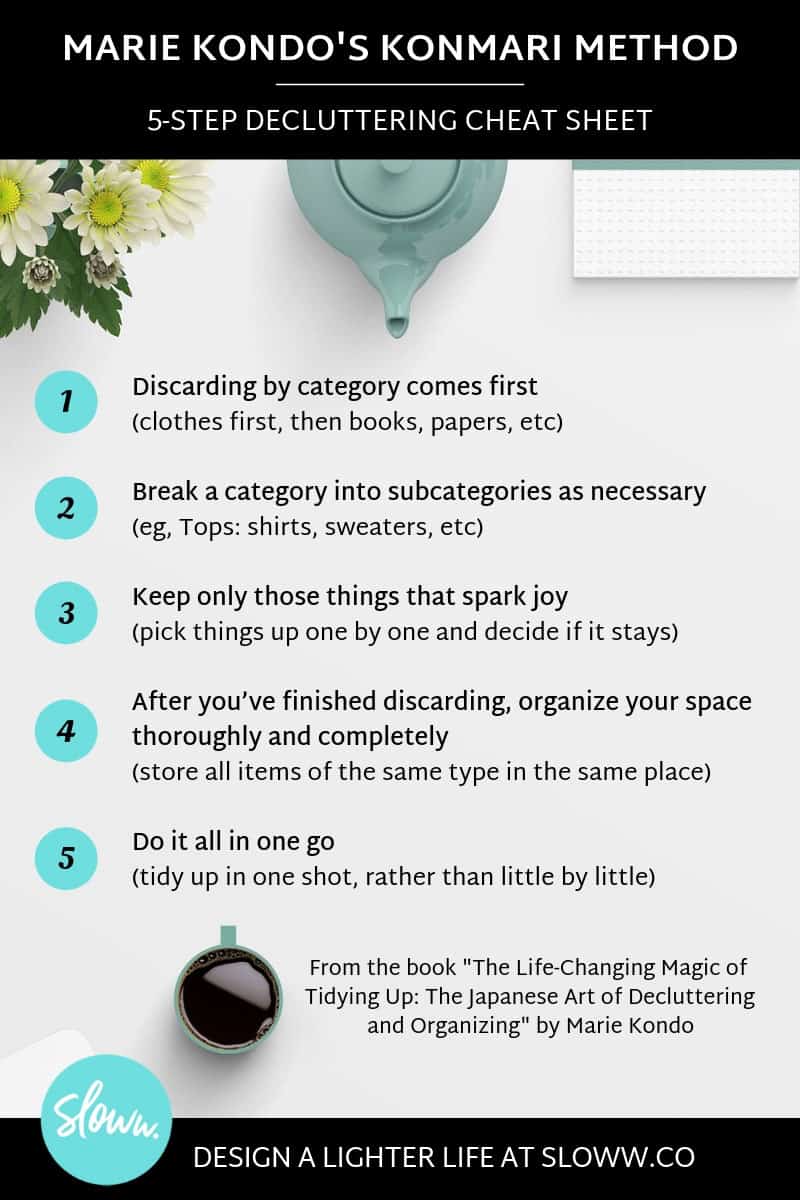
Marie Kondo’s Credentials
What sets Marie Kondo apart from other declutterers and professional organizers is that she’s dedicated the majority of her life to it from a young age. You could even say obsessive dedication.
She claims she’s dedicated 80% of her life to the subject. She started thinking about storage systems when she was 5 years old, and discovered her passion for discarding when she was a teenager.
And, her client track record speaks for itself. The people who use the KonMari Method never revert to clutter again.
Marie Kondo Debunks other Decluttering Methods
This was one of my favorite aspects of the book. Not only does she acknowledge other decluttering and organizing methods, she calls them out and says why they don’t work. She’s been there, done that. She’s tried them all.
Methods that don’t work: getting rid of one item a day, decluttering one room at a time, doing a little at a time, listening to music or the TV while you declutter, trying to get your possessions down to a certain number, getting rid of something you haven’t used in a set period of time, getting rid of one thing every time you buy something new, and most storage solutions.
- “Does it still sound too good to be true? If your idea of tidying is getting rid of one unnecessary item a day or cleaning up your room a little at a time, then you are right. It won’t have much effect on your life.”
- “‘Don’t aim for perfection. Start off slowly and discard just one item a day.’ What lovely words to ease the hearts of those who lack confidence in their ability to tidy.”
- “Tidying up by location is a fatal mistake.”
- “The majority of methods give clearly defined numerical goals, such as ‘Discard anything you haven’t used for two years,’ ‘Seven jackets and ten blouses is the perfect amount,’ ‘Get rid of one thing every time you buy something new.’ But I believe this is one reason these methods result in rebound.”
- “Those storage ‘solutions’ are really just prisons within which to bury possessions that spark no joy.”
Why People Clutter, Hoard, and Stockpile
- “The strange thing is that these clients never realized how many items they actually had until they began putting their house in order. And even though they owned a huge stockpile, they always felt as if they didn’t have enough and were anxious about running out. For people who stockpile, I don’t think there is any amount that would make them feel secure. The more they have, the more they worry about running out and the more anxious they become.” (Note: Maybe “Keeping Up With The Joneses” or lifestyle inflation?)
- “But when we really delve into the reasons for why we can’t let something go, there are only two: an attachment to the past or a fear for the future.”
- “Although we can get to know ourselves better by sitting down and analyzing our characteristics or by listening to others’ perspectives on us, I believe that tidying is the best way. After all, our possessions very accurately relate the history of the decisions we have made in life. Tidying is a way of taking stock that shows us what we really like.”
- “People have trouble discarding things that they could still use (functional value), that contain helpful information (informational value), and that have sentimental ties (emotional value). When these things are hard to obtain or replace (rarity), they become even harder to part with.”
- “There are three approaches we can take toward our possessions: face them now, face them sometime, or avoid them until the day we die. The choice is ours.” (Note: You have a choice)
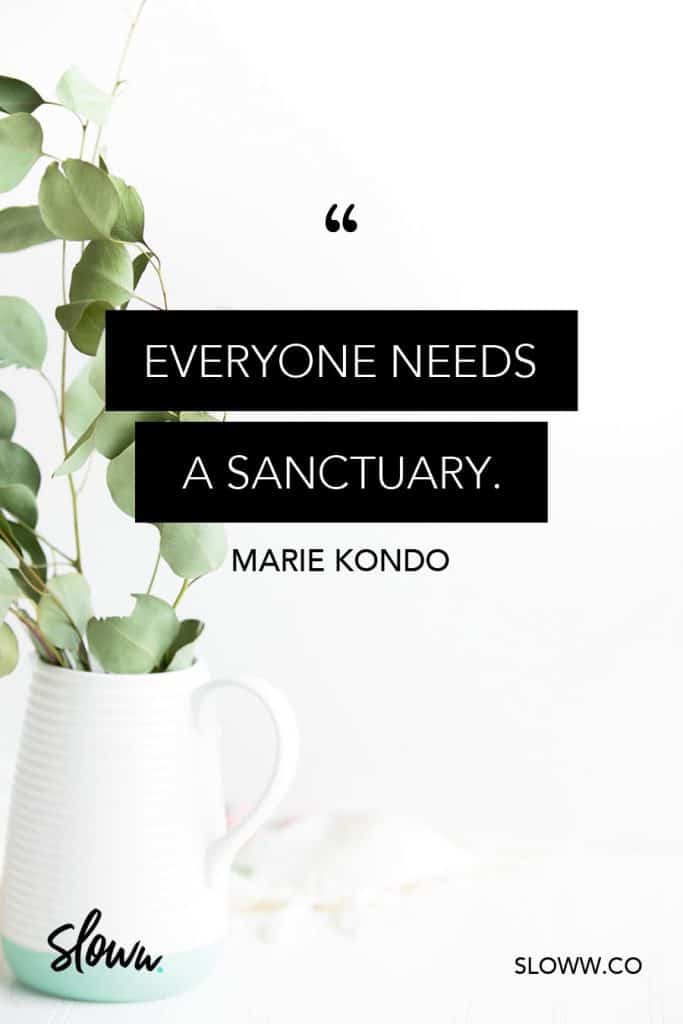
9 Top Themes from “The Life-Changing Magic of Tidying Up” by Marie Kondo
1) It Starts and Ends with your Mindset
- “People cannot change their habits without first changing their way of thinking. And that’s not easy!”
- “Remember: the KonMari Method I describe in this book is not a mere set of rules on how to sort, organize, and put things away. It is a guide to acquiring the right mindset for creating order and becoming a tidy person.”
- “When you tidy your space completely, you transform the scenery. The change is so profound that you feel as if you are living in a totally different world. This deeply affects your mind and inspires a strong aversion to reverting.”
2) Your Home is a Sacred Space
- “Everyone needs a sanctuary.”
- “One theme underlying my method of tidying is transforming the home into a sacred space, a power spot filled with pure energy.”
- “By eliminating excess visual information that doesn’t inspire joy, you can make your space much more peaceful and comfortable.”
3) And your Things are Alive
- “I began to treat my belongings as if they were alive when I was a high school student.”
- “Just like the gentle shake we use to wake someone up, we can stimulate our belongings by physically moving them, exposing them to fresh air and making them ‘conscious.'”
- “In Japan, people believe that things like cleaning your room and keeping your bathroom spick-and-span bring good luck, but if your house is cluttered, the effect of polishing the toilet bowl is going to be limited. The same is true for the practice of feng shui. It is only when you put your house in order that your furniture and decorations come to life.”
- “The concepts underpinning feng shui are the dual forces of yin and yang and the five elements (metal, wood, water, fire, and earth). The basic belief is that everything has its own energy and that each thing should be treated in a way that suits its characteristics. To me, this seems perfectly natural. The philosophy of feng shui is really about living in accordance with the rules of nature. The purpose of my approach to tidying is exactly the same. The true purpose of tidying is, I believe, to live in the most natural state possible. Don’t you think it is unnatural for us to possess things that don’t bring us joy or things that we don’t really need? I believe that owning only what we love and what we need is the most natural condition.”
4) Treat Decluttering as a One-Time Celebration
- “I begin my course with these words: Tidying is a special event. Don’t do it every day.”
- “I believe that tidying is a celebration, a special send-off for those things that will be departing from the house.”
- “In Japanese, the term is ikki ni, or ‘in one go.'”
- “Ultimate secret of success is this: If you tidy up in one shot, rather than little by little, you can dramatically change your mindset.”
- “It is best to tidy up quickly and get it over with. Why? Because tidying is not the purpose of life.”
5) The KonMari Method Outline
- “Two essential actions: discarding and deciding where to store things. Of the two, discarding must come first.”
- “This is why tidying must start with discarding. We need to exercise self-control and resist storing our belongings until we have finished identifying what we really want and need to keep.”
- “Ask yourself ‘Why?’ again, for each answer. Repeat this process three to five times for every item.” (Note: Sounds like the same process from Toyota of asking yourself “Why?” five times)
- “The best sequence is this: clothes first, then books, papers, komono (miscellany), and lastly, mementos.” (Note: We followed the KonMari Method for my wife’s clothing, and I’ll document the process in a separate post. For me, I went straight for clothing minimalism.)
- “Japanese word for healing is te-ate, which literally means ‘to apply hands.'”
6) The Selection Criteria is more than just “Spark Joy”
I think this is important because people can get hung up on “spark joy.” Marie Kondo uses a variety of words when describing what you should keep: “spark joy,” “inspire joy,” “thrill of pleasure,” “speak to your heart,” “moves you,” and “love.”
- “Selection criterion: does it spark joy?”
- “The criterion is, of course, whether or not it gives you a thrill of pleasure when you touch it.”
- “You’ve mastered what’s inside. Instead, take each book in your hand and decide whether it moves you or not.”
- “Keep things because you love them—not ‘just because.'”
- “Sorting will proceed smoothly, and you will be amazed by your capacity to choose on the basis of what gives you pleasure.”
- “Always, only keep the ones that inspire joy.”
7) It’s not Discarding — It’s Keeping what you Love
This is an important difference between the KonMari method and other decluttering methods. She focuses on what you are keeping instead of what you are discarding. So, it’s less about what’s leaving your life and more about what’s staying to bring you daily joy.
- “If I had been a little smarter, I would have realized before I became so neurotic that focusing solely on throwing things away can only bring unhappiness. Why? Because we should be choosing what we want to keep, not what we want to get rid of.”
- “I came to the conclusion that the best way to choose what to keep and what to throw away is to take each item in one’s hand and ask: “Does this spark joy?” If it does, keep it. If not, dispose of it.”
- “I chose this standard for a reason. After all, what is the point in tidying? If it’s not so that our space and the things in it can bring us happiness.”
- “Keep only those things that speak to your heart. Then take the plunge and discard all the rest. By doing this, you can reset your life and embark on a new lifestyle.”
- “I can think of no greater happiness in life than to be surrounded only by the things I love. How about you?”
8) Next Comes Organizing
- “You must begin by discarding. Once you have done that, it’s easy to decide where things should go because your possessions will have been reduced to a third or even a quarter of what you started out with.”
- “When you are choosing what to keep, ask your heart; when you are choosing where to store something, ask your house.”
- “Clutter is caused by a failure to return things to where they belong. Therefore, storage should reduce the effort needed to put things away, not the effort needed to get them out.”
- “The secret to maintaining an uncluttered room is to pursue ultimate simplicity in storage so that you can tell at a glance how much you have.”
- “I have only two rules: store all items of the same type in the same place and don’t scatter storage space.”
9) Transform Your Home to Transform Your Life
- “A dramatic reorganization of the home causes correspondingly dramatic changes in lifestyle and perspective. It is life transforming.”
- “It’s a very strange phenomenon, but when we reduce what we own and essentially ‘detox’ our house, it has a detox effect on our bodies as well.”
- “I think the main reason tidying has this effect is because through this process people come to know contentment. After tidying, many clients tell me that their worldly desires have decreased. Whereas in the past, no matter how many clothes they had, they were never satisfied and always wanted something new to wear, once they selected and kept only those things that they really loved, they felt that they had everything they needed.”
- “‘Ah! This is just the amount I need to live comfortably. This is all I need to be happy. I don’t need anything more.’ The satisfaction that envelops your whole being at that point is palpable. I call this the ‘just-right click point.'” (Note: Read more “aha moments” from the top names in slow and simple living)
- “Tidying is just a tool, not the final destination. The true goal should be to establish the lifestyle you want most once your house has been put in order.”
- “Pour your time and passion into what brings you the most joy, your mission in life. I am convinced that putting your house in order will help you find the mission that speaks to your heart. Life truly begins after you have put your house in order.” (Note: The Japanese also have a great process for creating your life purpose called Ikigai)
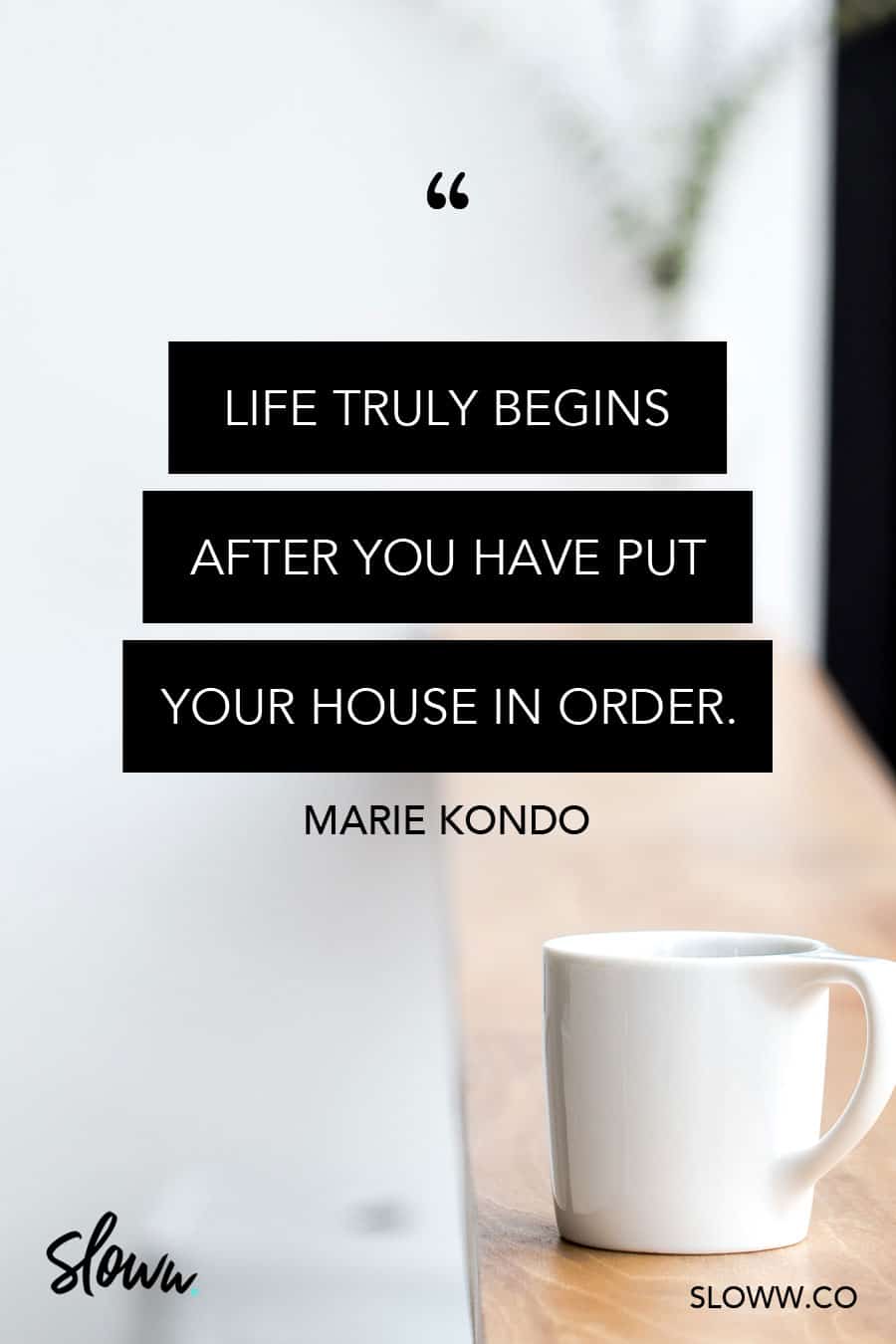
Have you read the book? Share what was most life-changing for you in the comments.
And, you can check out all of my book summaries here.
Slow Living Resources:
Slow Living 101 | Slow Living Challenges | Slow Living Online Forums & Communities | Slow Living Quotes | Slow Living Videos
You can learn a little more about me, see what I’m working on now, and follow Sloww via email using the form field below this post or on social media: Twitter | Facebook | Instagram | Pinterest | Medium | Reddit | Quora




